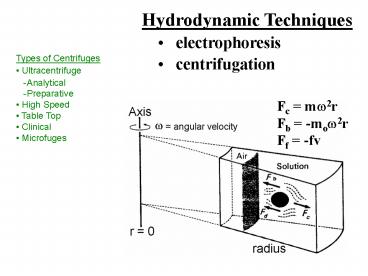Hydrodynamic Techniques - PowerPoint PPT Presentation
1 / 10
Title:
Hydrodynamic Techniques
Description:
Density Gradients. centrifugation in a dense medium. increases stability ... separates by density. Example of Isopycnic Separation. Percoll, self-forming gradient ... – PowerPoint PPT presentation
Number of Views:462
Avg rating:3.0/5.0
Title: Hydrodynamic Techniques
1
- Hydrodynamic Techniques
- electrophoresis
- centrifugation
- Types of Centrifuges
- Ultracentrifuge
- -Analytical
- -Preparative
- High Speed
- Table Top
- Clinical
- Microfuges
2
v ?2rm?(?p - ?s)/f
- The greater the centrifugal force (?2r), the
faster the particle sediments. - The more massive a particle, the faster it moves
in a centrifugal field. - The denser a particle, the faster in moves in a
centrifugal field. - The denser the solvent, the slower the particle
will move in a centrifugal field. - The particle velocity is 0 when the solvent
density is greater than the particle density. - The greater the frictional coefficient (factors
such as solvent viscosity, particle shape, etc.),
the slower the particle will move.
3
- Sedimentation Coefficient (s)
- is the velocity per Fc, or
- s v/?2r
- units are the Svedberg (S), where 1 S 10-13 sec
m?(?p - ?s)/f
Analytical vs Preparative Centrifugation
4
- collect material
- cells
- precipitated macromolecules
- subcellular fractionation
5
Differential Centrifugation
- prepare cell lysate
- subject to centrifugation
- centrifugal force
- time (g min)
- tube size and shape
- rotor angle
- separate supernatant and pellet
- re-centrifuge supernatant
- Relative Centrifugal Force
- expressed as x gravity
- RCF Fc/Fg ?2r/980
- ? ?(rpm)/30
- RCF 1.119 x 105 (rpm)2r
- radius in cm
6
- Problems
- contamination
- large particles contaminated with smaller
particles - resolution
- particles of similar sizes not separated
- vibrations and convection currents
- Density Gradients
- centrifugation in a dense medium
- increases stability
- provides greater resolution
- common media sucrose, CsCl, Ficoll, Hypaque,
Percoll
7
Density Gradient Centrifugation
- Two Types
- 1) Rate Zonal ? ?p gt ?s
- separates primarily by mass
- 2) Isopycnic ? ?p lt ?s
- equilibrium
- separates by density
8
Example of Isopycnic Separation
- Percoll, self-forming gradient
- light vs. heavy fraction
9
General Procedures
- 2) apply sample
- layer on top
- bottom (isopycnic)
- dispersed (self forming)
3) centrifuge
- 1) prepare gradient
- step
- continuous
- self-forming (isopycnic)
10
- 4) collect and analyze fractions
- manually aspirate bands
- fraction collector
- Measuring Density
- marker beads
- refractometer































